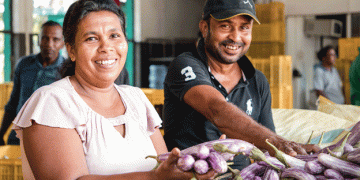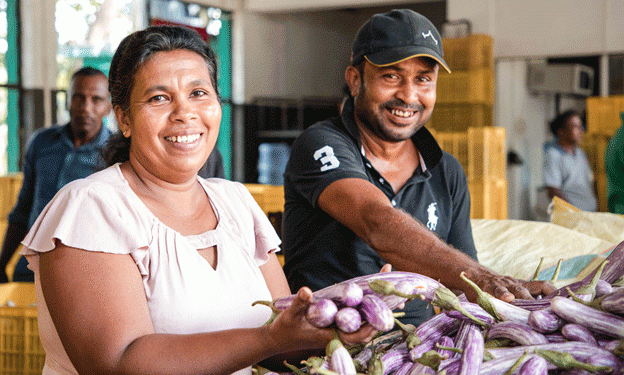In a small village in southeastern Sri Lanka, Nirosha Dilmini starts her day early, harvesting eggplants from her modest quarter-acre plot. For six years, Nirosha has farmed this land, but she had never seen a harvest as bountiful as in 2023. “Our yield now is what we used to expect from a full acre,” she proudly shares, taking a break from the morning’s work. The transformation she experienced is the result of the Good Agricultural Practices (GAP) initiative, spearheaded by the Food and Agriculture Organization (FAO) in response to the country’s growing food security challenges.
The GAP Initiative: A Lifeline for Farmers During Crisis
The GAP program was launched as a response to Sri Lanka’s economic crisis, which heightened concerns about food security. Supported by the United Nations Sri Lanka Sustainable Development Goals Fund, GAP provides farmers with tools and training to modernize their farming techniques, helping them increase both yield and profitability. Nirosha was one of 645 farmers across three regions in Sri Lanka who participated in the program and received equipment that has dramatically reduced the costs and labor required to manage their farms.
Each farmer was provided with an agricultural toolkit that included essential resources like drip irrigation systems, plastic mulch, and insect nets. These tools have proven crucial in helping farmers reduce input costs and improve the efficient use of key resources such as water, fertilizers, herbicides, and pesticides.
Transforming Agriculture with Modern Tools
The drip irrigation system, in particular, has been a game-changer for Nirosha. “Before, it would take me a full day to apply fertilizer,” she recalls. “Now, with a 20-liter tank, I can cover 500 plants quickly and easily. The plastic mulch has also helped reduce weed growth, which has saved me a lot of time.” By reducing labor and resource consumption, these innovations have allowed her to work more efficiently, increasing her farm’s productivity while lowering operational costs.
In 2023, Nirosha also experienced a significant shift in her farm’s growing cycle. Traditionally, the period between May and August, during the gap between the two monsoon seasons, was a lean time when farming activities slowed down. However, since adopting the GAP techniques, she has been able to farm consistently year-round, extending her growing season and generating additional income during what used to be the most challenging months of the year.
“Now, we can maximize production, even in the toughest weather conditions, with minimal water use,” says Nirosha, noting that the technology has allowed her to ensure productivity regardless of environmental challenges.
Sustainable Agriculture and Higher Yields
The GAP initiative’s success is not limited to a few individuals; it has had a widespread impact across the participating regions. Over the past year, farmers have reported yield increases, particularly in key crops like eggplant, okra, and beans. For Nirosha, 2023 marked a major turning point, as she was able to plant continuously, and her yields were significantly higher compared to previous years.
The integration of modern technologies, such as drip irrigation, plastic mulch, and pest control nets, has been a critical factor in reducing crop loss and improving resource efficiency. In addition to the practical benefits of these tools, farmers received immersive training through Farmer Field Schools, learning how to apply GAP principles like environmental sustainability, food safety, economic viability, and social acceptability. The knowledge and tools they gained not only helped them achieve GAP certification but also made their farming practices more sustainable and profitable.
Increased Income and Market Access
The financial benefits of the GAP program are clear. According to FAO data, 32% of participating farmers reported earning at least an additional $65 per month from their quarter-acre plots, thanks to the improved yields and efficiencies they achieved. This increase is significant in regions where smallholder farmers rely on their crops as their primary source of income.
Beyond higher yields and reduced costs, one of the most impactful outcomes of the GAP initiative has been the farmers’ access to new markets. By forming partnerships with local supermarket chains, farmers like Nirosha are now able to sell their produce in bulk at more competitive prices. Additionally, knowledge-sharing initiatives, such as social media promotions and field visits to GAP-certified farms, have helped spread modern farming techniques throughout the farming community.
A Path to Sustainable Agricultural Development
Nirosha’s story is a powerful example of how modern agricultural practices, combined with the right support, can transform small-scale farming. With the continued backing of FAO and other partners, farmers in Sri Lanka are not only improving their livelihoods but also contributing to the country’s broader goals of sustainable agricultural development.
The GAP initiative has not only helped individual farmers increase their incomes but has also laid the foundation for long-term food security and sustainability in rural communities. As farmers continue to adopt modern practices, the future of Sri Lankan agriculture looks brighter than ever.
The success of Nirosha Dilmini and her fellow farmers illustrates the profound impact that modern agricultural technologies can have on small-scale farming. By providing tools, training, and market access, the GAP initiative has empowered farmers to increase productivity, reduce costs, and improve their overall quality of life. As more farmers adopt these practices, the potential for sustainable agricultural development in Sri Lanka continues to grow.































